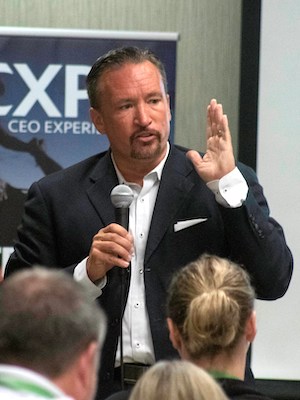
On January 30, 2019, The World Health Organization declared the outbreak of a novel coronavirus (a.k.a. #COVID–19) a global health emergency. The acknowledgement of the risk the virus posed to countries beyond its origin in China and of the need for a more coordinated international response to the outbreak has become increasingly clear. Meanwhile, the resulting market downturn has reminded all leaders of the value of life and how quickly things can change.
Although many companies can survive serious circumstances, such as a global pandemic, any downturn in the market and anxiety amongst your team will have a lasting impact on business.
In the weeks and months ahead, every leader will engage with employees, partners, and customers that will deal with mounting worry, anxiety, and confusion. I often work with CEOs and companies that deal with unexpected changes, sudden layoffs, and/or an unexpected employee exits that impact the organization.
In difficult times a critical question becomes apparent: “What is a leaders’ role during an unexpected crisis?
Leading your team in the face of unexpected change
1. Show up!
In his book, Leadership, former New York Mayor Rudy Giuliani wrote about a core principle he practiced during the tragic period after 9/11.
He wrote about the importance of a leader’s presence during difficult times and asserted that “Weddings are discretionary; funerals are mandatory.” He continued, “(Weddings are) important; a leader ought to join with people in enjoying those rewards for hard work and sacrifice. But when the chips are down––when someone you care about is struggling for answers or burying a loved one––that’s when the measure of a leader is taken.”
The lesson is clear: Leaders need to understand that their presence is needed most when there are times of grief and sorrow. Unexpected changes and difficult times present opportunities to relate to your team and walk together through difficult moments in life and business. A leader that shows up at funerals, or at the hospital, or a persons’ home during crises builds morale and loyalty.
Experience Question: How can you show you are committed to being there for your people in difficult times?
2. Remain empathetic and steady
It’s time to reset expectations and directions. A team that is experiencing excess stress, uncertainty, sorrow, and/or grief cannot move at the same speed as a fully functioning team. Leaders need to understand the impact of the situation and reset expectations.

Be a steady hand in a difficult time to guide (and not demand) during turbulent times. A leader that drives a team member harshly during a difficult time (at an individual, household, and national level) will provoke resentment and anger. Being a good leader is knowing when to challenge, encourage, and when to sit with your people.
Experience Question: Do your people know you have reasonable expectations during challenging times?
3. Be thoughtful
Remember the significance of the situation at hand. One of the best leadership practices a mentor taught me was to remember the significant events in people’s lives.
It is a powerful thing when a leader shows up during the time of difficulty in someones’ life. It is a defining moment when a leader sends a note to the person telling them they are thinking about that person and understand the significance of their trouble and pain. A leaders’ calendar should be filled with important dates in the lives of their team. These dates could include the loss of someone significant, the date they received a bad health diagnosis or a divorce.
Experience Question: Could you mark your calendar or ask an assistant to create a process to remember the significant dates in the lives of your team?
4. Show resolve
Be more committed than ever to moving forward. In times of worry and change, people look to their leader for direction. During hard times in the life of the company, people need to see leaders that will lead their people to a better place.
“It is during these difficult times that real leaders emerge forged by the fire and battle-ready to meet the future ahead.”Ken Gosnell
It is during these difficult times that real leaders emerge forged by the fire and battle-ready to meet the future ahead.
Leaders who move their organization forward during times of worry and looming defeat will work diligently to develop an attitude of resiliency. These leaders inspire teams to act even when paralyzed by fear. These leaders understand that even in the worst of times, some businesses and organizations make progress, develop profits, and find new solutions for the problems that people face.
Resilient leaders are determined to turn the difficulty into a defining moment of breakthrough. These leaders work tirelessly to sow seeds in the storm so that they can reap a harvest for years to come. How a leader leads during difficult times will establish how quickly the company and team move forward after being set back.
Experience Question: Do you have a plan that tackles how to lead forward in a time of a setback?
Lead well
Leaders have to lead during times of difficulty and hardship. The question is not if you will face times of worry, stress, and setbacks, it is how will you lead during these times.
Leaders have an important role during uncertain times. And when you lead correctly during this time, everyone benefits. In truth, your people, your team, and your organization will all become better if you lead better during hard and difficult times.
Ken Gosnell is the CEO and Servant Leader of CXP (CEO Experience). He serves leaders by helping them to have great experiences that both transform them and their organizations that enable to go further faster. He has worked with hundreds of CEOs and leadership teams to enhance strategic, operational and people accomplishments. He is an author, coach, and strategic partner with CEOs. Ken is the creator and facilitator of the Christian CEO Linkedin Group and creator of the CEO Experience Impact Assessment. He is married to Shonda, and they have four children. Connect with @ken_gosnell on Twitter.
© YFS Magazine. All Rights Reserved. Copying prohibited. All material is protected by U.S. and international copyright laws. Unauthorized reproduction or distribution of this material is prohibited. Sharing of this material under Attribution-NonCommercial-NoDerivatives 4.0 International terms, listed here, is permitted.













